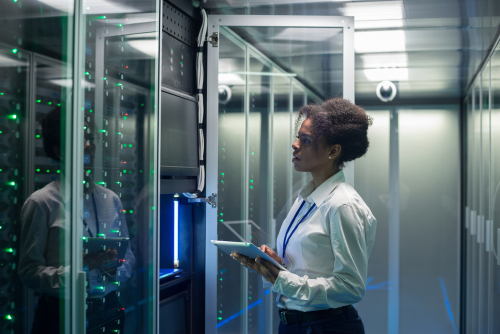via Planet Mainframe
The first mainframe computer was invented almost one hundred years ago, in the late 1930s, when a Harvard University researcher needed help solving a series of equations. Since then, mainframes have consistently been an undeniable resource to organizations and enterprises across the globe—with over 71% of Fortune 500 companies relying on mainframes as part of their regular operations.
However, because the mainframe has been integral for so long, it needs updating, and the path to modernization is not a one-time event but a continuous journey. With the right tools, organizations can modernize at their own pace while remaining viable. Aligning IT with business needs to meet fundamental goals such as improving customer experience and increasing market share is more important than ever—regardless of whether operating on mainframes, midrange servers, the cloud, or somewhere in between.
As businesses embark on modernizing their mainframe and its applications, they unlock many opportunities for growth and innovation. Understanding the advantages of cloud and application modernization lays the groundwork for this transformative process. Although there are some challenges enterprises will face with modernization, with a continuous modernization plan that strategically drives automation and ongoing business results, myths can be busted, and organizations can achieve their desired results.
Here are three common myths associated with mainframe modernization and how organizations can overcome them to unlock their best, modern potential.
Myth 1: “You already know everything you need to start your modernization journey.”
Some organizations believe they can bypass comprehensive process discovery and jump into modernization, swiftly adopting new technologies without investing time in thoroughly exploring the business and its data. Organizations might think diving into modernization without complete process discovery will not significantly impact the outcome; however, this overlooks the critical role that understanding current workflows, systems, and bottlenecks plays in successful modernization initiatives.
As the initial step in mainframe modernization, process discovery is the bedrock for informed decision-making. It involves delving into the existing infrastructure, workflows, and technologies to discern inefficiencies, redundancies, and areas ripe for improvement. By bypassing or skimming over this phase, organizations risk missing crucial insights that could dictate the success or failure of the modernization journey.
Collaboration across departments and teams becomes pivotal here. A diverse range of perspectives brings a more comprehensive understanding of how different areas within the organization operate. Involving stakeholders from various departments ensures that the modernization plan is aligned with diverse needs and challenges across the organization. This critical phase provides insights into the current state of affairs and lays the groundwork for estimating project timelines, mitigating cost overruns, and anticipating potential pitfalls. It’s akin to mapping the terrain before embarking on a journey, allowing organizations to chart a more strategic and efficient route toward modernization.
By engaging in comprehensive process discovery, organizations gain a nuanced understanding of their current systems, enabling them to identify pain points, anticipate challenges, and strategically plan for successful modernization. This collaborative, data-driven approach sets the stage for a more informed and effective modernization process aligning with the organization’s objectives and goals.
Myth 2: “All modernization is good modernization.”
A misconception exists that all modernization projects are equally impactful. In reality, strategic prioritization based on business goals is crucial. Not all modernization efforts achieve business objectives or deliver immediate value. Organizations can optimize their modernization investments by strategically evaluating and prioritizing initiatives based on their alignment with overarching business goals.
This strategic approach ensures that resources, time, and efforts are channeled toward initiatives that promise the most significant business impact. Prioritizing modernization efforts according to their alignment with key business objectives not only garners support from stakeholders by showcasing the direct link between initiatives and business outcomes but also ensures that the organization’s modernization journey is purposeful, efficient, and aligned with its long-term vision.
Myth 3: “Automation execution is solely about task completion.”
The centralized management of robots and APIs through DevOps tools only where necessary across the organization extends modernization and automation enhancements to developer environments, ensuring a cohesive and efficient approach to modernizing and automating various processes. The myth surrounding automation execution often centers on a narrow perspective of its capabilities, focusing solely on task completion rather than its transformative potential.
Some organizations view automation as a tool for merely replacing manual tasks without fully recognizing its broader implications for organizational growth and innovation. Beyond automating repetitive tasks, automation holds the key to unlocking human potential within an organization. While it streamlines routine workflows, its value lies in liberating human resources from mundane activities, enabling them to focus on higher-value, creative, and strategic endeavors. This shift in focus from task completion to employee empowerment represents a paradigmatic change in how organizations should approach automation. Organizations that understand and embrace this perspective of automation are better positioned to leverage technology as a catalyst for growth, innovation, and sustained competitive advantage.
As enterprises navigate their modernization journeys, debunking these myths paves the way for a more purposeful, efficient, and innovation-driven approach. Modernization is not a path with an end destination; it’s a continuous process. By acknowledging the importance of in-depth understanding, strategic prioritization, and holistic views of automation, organizations can harness the true potential of mainframe modernization, fostering a culture of innovation and resilience in the face of evolving technological landscapes. Embracing these truths unlocks the door to a transformative modernization journey poised for success in the ever-evolving digital era.

